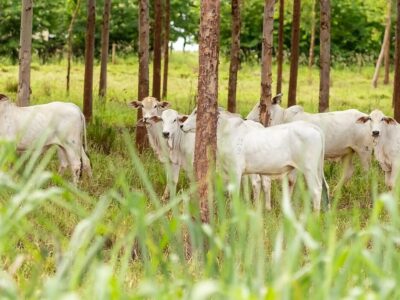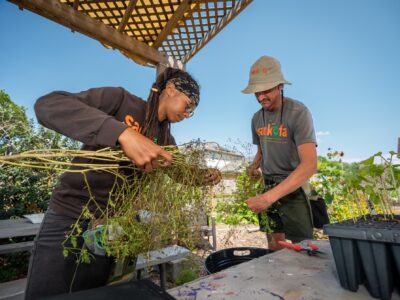
When Brad and Margaret Buchanan purchased a 520-acre parcel of land in eastern Colorado back in 2006, they had no intention of starting a cattle ranch. Brad Buchanan had fallen in love with the state’s Eastern Plains – its agricultural heartland – and the husband and wife decided to make the property home. However, Mr. Buchanan discovered the parcel, part of a 100-year ranch operation, had a landscape that needed cattle to thrive. So, in 2007, the two purchased 22 head of cattle, and Flying B Bar Ranch was born.
Today, the Buchanan’s all grass-fed cattle ranch, less than an hour east of Denver, is home to nearly 900 Black Angus cattle. The ranch is unique in that the cattle are treated with the utmost care and live in an environment managed with eco-friendly, regenerative farming practices. This stems from Mr. Buchanan’s desire to preserve the fragile prairie landscape.
Flying B Bar sells beef to customers in the Denver area at its online store for in-person pickup. The store also offers online ordering and shipping to people in neighboring states, with a section on its site explaining how delivery works. Additionally, Denver-area customers who wish to see the ranch during pickup can do so by making an appointment.
The ranch is co-owned and operated by architect-turned rancher Brad Buchanan and Rob Gary, with Jonathan Tullar as the ranch manager. From 2014 to 2018, Buchanan served as Denver’s planning director after more than 25 years of design and construction work in the city. He is also the CEO of The National Western Center Authority – a 250-acre Denver food and agriculture hub set to open in 2024.
Consensus spoke with Mr. Buchanan about Flying B Bar, his mission to ensure welfare for his cattle, and his passion for conservation. It all starts with the cattle’s diet.
Cows on the ranch are “all grass-fed and grass-finished,” meaning they are fed only grass and hay – what they eat in nature – and are never given growth hormones or steroids. This is in contrast to other operations where cattle are fed an unnatural combination of grain/corn/soy, growth hormones, and steroids.
“The truth is, we don’t grow cattle, we grow grass – and when we grow grass, we end up growing cattle,” said Buchanan. “There are a lot of people that are learning about and are interested in feeding that to their families.” “This is just clean beef. This is grass and sunshine. There’s no steroids, no antibiotics, no hormones, there’s no grain – it’s just clean beef, and you can taste that difference,” he added.
Not only is grass better for the cattle – but it also makes a healthier meal for the consumer. According to Healthline, grass-fed beef generally contains higher amounts of Vitamin E and Vitamin A and tends to be richer in antioxidants. Additionally, grass-fed beef can contain up to five times as much omega-3s and twice as much conjugated linoleic acid (CLA). Studies have shown those who eat a lot of CLA are at lower risk for cancer, type 2 diabetes, and other diseases.
In the U.S., seven to nine months after birth, most conventionally raised cows are shipped to large feedlots where they are quickly fattened with a combination of grains, steroids, and antibiotics. A few months later, the cows are sent to slaughterhouses. However, this is not the case at Buchanan’s ranch.
“At the Flying B, instead of getting in a trailer for the feedlot after weaning, our cattle head back to the grass pasture, and there they stay until they are ready to come home for dinner,” according to Flying B Bar. “And if the pastures need to be supplemented during the winter, we only feed hay farmed right here at the ranch, usually Sorghum/Sudangrass and alfalfa.”
While Buchanan’s grass-only approach for raising cattle takes longer than conventional methods, seeing them live happier lives compensates for the lost time.
“Our cows spend their entire lives in wide-open pastures. They eat grass—the food that they were naturally intended to eat, in the environment where they are naturally found,” Flying B Bar’s site explains. “Because of their low-stress lifestyle, our cows are rarely sick, and grow at a natural rate.”
Flying B Bar also uses one of Colorado’s two Animal Welfare-approved slaughter facilities – Atlas Meats – to ensure proper sanitation and no pain or suffering for the animals.
“We respect our animals and we honor our animals, and that includes the slaughter process,” said Buchanan. “We are very much animal people here in the Buchanan family and in the Flying B Bar Ranch Family. So, we wanted to find a slaughter facility that shared those values and cared about the animal experience – that the process of slaughter was humane, instant, and stress-free to the animals.”
Eco-friendly farming is an integral part of the ranch’s daily operations. Flying B Bar never uses fertilizer, herbicides, or chemicals on its pastures, and deploys a form of regenerative agriculture called rotational grazing. With the assistance of a grazing design app and a group of cowboys, Buchanan moves electric fencing to relocate the cows to different plots of land. This is a “modern ranching method intended to replicate the way “ruminants,” or grass-eating mammals, historically coevolved with grasslands,” according to 5280.
Moving the cattle periodically helps prevent overgrazing and allows the soil to receive the benefits associated with grazing. As 5280 explains, “The animals’ waste contributes to fecundity; and all the trampling aerates, spreads seeds, and works dead plant matter down into the soil” – which creates water retention and soil and plant carbon generation.
Flying B Bar has seen sales increase steadily since its launch, but last year was different. The company saw profit skyrocket to nearly $2 million – more than double its 2019 figure, Buchanan notes. Last month, Flying B Bar did three times its January 2020 figures. Despite this commercial growth, employing cleaner practices and supporting the community remains at the heart of Flying B Bar’s operation.
“We’re mission-driven here around something that’s better for the planet, better for people, and better for the cattle,” Buchanan emphasized. “Our goal is not to be the biggest beef operation. Our goal is to be the right beef operation and to support the people that work here, to support our community, and to support our buyers. There’s room for everybody here.”




